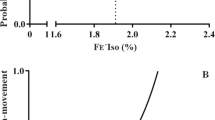Abstract
The effect of low concentration sevoflurane and halothane on the ventilatory response to isocapnic hypoxia was studied in sixteen cats. The cats were divided into two groups, sevoflurane group and halothane group, of eight subjects each. As parameters of the hypoxic ventilatory response, A value [the slope of the hyperbolic curve,\(\dot V_E = \dot V_0 + A/(Pa_{O_2 } - 32)]\) and ratio of\(\dot V_{50} \) (the minute volume obtained from the hyperbolic equation when PaO 2=50 mmHg) to\(\dot V_0 \) were studied. These two parameters were examined at three states, sedative state with ketamine as the control, ketamine plus 0.1 MAC inhalation anesthetic, and ketamine plus 0.5 MAC inhalation anesthetic. In the sevoflurane group, the A values were 4789±1518, 2187±1214, 1730±880 (mean ± SE. ml·min−1·mmHg) at the control state, 0.1 MAC and 0.5 MAC, respectively. In the halothane group, the A values were 6411±2368, 2529±842 and 2372±545, respectively. The ratios of\(\dot V_{50} \) to\(\dot V_0 \) were 1.32±0.09, 1.22±0.09, 1.25±0.08 in the sevoflurane group, 1.47±0.18, 1.32±0.11, 1.54±0.18 in the halothane group, respectively. The A value at 0.1 MAC of the halothane group was less than the control value significantly. This proved that even low concentration halothane depressed the hypoxic ventilatory responses. The depression of hypoxic ventilatory response could cause postanesthetic hypoventilation. On the other hand, we could not find significant depression on the hypoxic ventilatory response in the sevoflurane group, but we should notice that variances of the hypoxic ventilatory response were large.
Similar content being viewed by others
References
Knill R, Gelb A: Ventilatory responses to hypoxia and hypercapnia during halothane sedation and anesthesia in man. Anesthesiology 49:244–251, 1978
Severinghaus JW: Continuously recording ventimeter. Anesthesiology 23:582, 1962
Weiskoph RB, Raymond LW, Severinghaus JW: Effects of halothane on canine respiratory responses to hypoxia with and without hypercarbia. Anesthesiology 41:350–360, 1974
Hirshman CA, McCullough RE, Cohen P J, Weil JV: Hypoxic ventilatory drive in dogs during thiopental, ketamine, or pentobarbital anesthesia. Anesthesiology 43:628–634, 1975
Bongo K, Tanaka S, Hori Y, Kurokawa K: Studies on general anesthesia in cats (in Japanese). Bulletin of the Nippon Veterinary and Zootechnical College 21:55–58, 1972
Kronenberg R, Hamilton FN Gabel R, Hickey R, Read DJC, Severinghaus J: Comparison of three methods for quantitating respiratory response to hypoxia in man. Resp Physiol 16:109–125, 1972
Lloyd BB, Jukes MGM, Cunningham DJC: The relation between alveolar oxygen pressure and the respiratory response to carbon dioxide in man. Q J Exp Physiol 43:214–227, 1958
Weil JV, Byrne-Quinn E, Sodal IE, Friesen WO, Underhill B, Filley GF, Grover RF: Hypoxic ventilatory drive in normal man. J Clin Invest 49:1061–1072,1970
Nishimura M, Kawakami Y: Low responders and hypoxic depression in hypoxic ventilatory response (in Japanese). Respiration and Circulation 32:349–356, 1984
Whitelaw WA, Derenne JP, Milic-Emili J: Occulusion pressure as a measure of respiratory center output in conscious man. Resp Physiol 23:181–199, 1975
Kohchi T, Nishino T, Honda Y, Yonezawa T, Mizuguchi T: Effects of the peripheral chemoreceptor denervation and increasing depths of halothane anesthesia on hypoxic respiratory depression (in Japanese). Masui (Jpn J Anesthesiol) 35:1680–1684, 1986
Sackner JD, Nixon AJ, Davis B, Atkins N, Sackner MA: Non-invasive measurement of ventilation during exercise using a respiratory inductive plethysmograph. Am Rev Respir Dis 122:867–871, 1980
Weiskopf RB, Gabel RA: Depression of ventilation during hypoxia in man. J Appl Physiol 39(6):911–915,1975
Author information
Authors and Affiliations
About this article
Cite this article
Tamura, C., Doi, M. & Ikeda, K. Hypoxic ventilatory response in cats lightly anesthetized with ketamine: effects of halothane and sevoflurane in low concentrations. J Anesth 5, 233–238 (1991). https://doi.org/10.1007/s0054010050233
Received:
Accepted:
Issue Date:
DOI: https://doi.org/10.1007/s0054010050233




